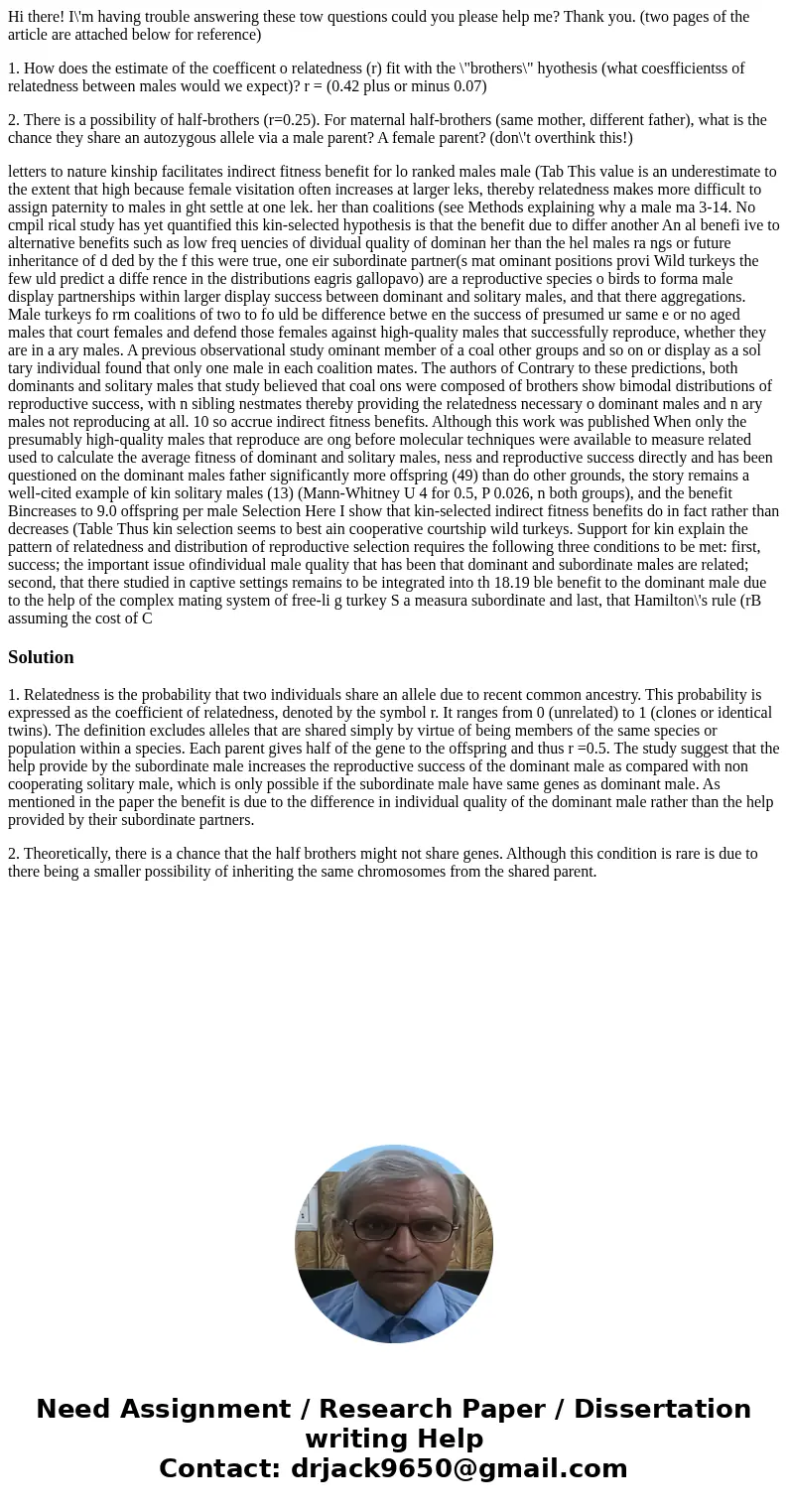Hi there Im having trouble answering these tow questions cou
Hi there! I\'m having trouble answering these tow questions could you please help me? Thank you. (two pages of the article are attached below for reference)
1. How does the estimate of the coefficent o relatedness (r) fit with the \"brothers\" hyothesis (what coesfficientss of relatedness between males would we expect)? r = (0.42 plus or minus 0.07)
2. There is a possibility of half-brothers (r=0.25). For maternal half-brothers (same mother, different father), what is the chance they share an autozygous allele via a male parent? A female parent? (don\'t overthink this!)
letters to nature kinship facilitates indirect fitness benefit for lo ranked males male (Tab This value is an underestimate to the extent that high because female visitation often increases at larger leks, thereby relatedness makes more difficult to assign paternity to males in ght settle at one lek. her than coalitions (see Methods explaining why a male ma 3-14. No cmpil rical study has yet quantified this kin-selected hypothesis is that the benefit due to differ another An al benefi ive to alternative benefits such as low freq uencies of dividual quality of dominan her than the hel males ra ngs or future inheritance of d ded by the f this were true, one eir subordinate partner(s mat ominant positions provi Wild turkeys the few uld predict a diffe rence in the distributions eagris gallopavo) are a reproductive species o birds to forma male display partnerships within larger display success between dominant and solitary males, and that there aggregations. Male turkeys fo rm coalitions of two to fo uld be difference betwe en the success of presumed ur same e or no aged males that court females and defend those females against high-quality males that successfully reproduce, whether they are in a ary males. A previous observational study ominant member of a coal other groups and so on or display as a sol tary individual found that only one male in each coalition mates. The authors of Contrary to these predictions, both dominants and solitary males that study believed that coal ons were composed of brothers show bimodal distributions of reproductive success, with n sibling nestmates thereby providing the relatedness necessary o dominant males and n ary males not reproducing at all. 10 so accrue indirect fitness benefits. Although this work was published When only the presumably high-quality males that reproduce are ong before molecular techniques were available to measure related used to calculate the average fitness of dominant and solitary males, ness and reproductive success directly and has been questioned on the dominant males father significantly more offspring (49) than do other grounds, the story remains a well-cited example of kin solitary males (13) (Mann-Whitney U 4 for 0.5, P 0.026, n both groups), and the benefit Bincreases to 9.0 offspring per male Selection Here I show that kin-selected indirect fitness benefits do in fact rather than decreases (Table Thus kin selection seems to best ain cooperative courtship wild turkeys. Support for kin explain the pattern of relatedness and distribution of reproductive selection requires the following three conditions to be met: first, success; the important issue ofindividual male quality that has been that dominant and subordinate males are related; second, that there studied in captive settings remains to be integrated into th 18.19 ble benefit to the dominant male due to the help of the complex mating system of free-li g turkey S a measura subordinate and last, that Hamilton\'s rule (rB assuming the cost of CSolution
1. Relatedness is the probability that two individuals share an allele due to recent common ancestry. This probability is expressed as the coefficient of relatedness, denoted by the symbol r. It ranges from 0 (unrelated) to 1 (clones or identical twins). The definition excludes alleles that are shared simply by virtue of being members of the same species or population within a species. Each parent gives half of the gene to the offspring and thus r =0.5. The study suggest that the help provide by the subordinate male increases the reproductive success of the dominant male as compared with non cooperating solitary male, which is only possible if the subordinate male have same genes as dominant male. As mentioned in the paper the benefit is due to the difference in individual quality of the dominant male rather than the help provided by their subordinate partners.
2. Theoretically, there is a chance that the half brothers might not share genes. Although this condition is rare is due to there being a smaller possibility of inheriting the same chromosomes from the shared parent.

 Homework Sourse
Homework Sourse